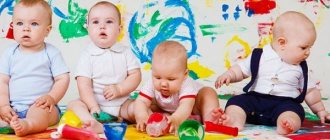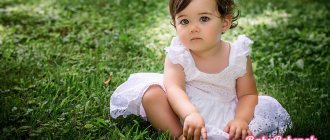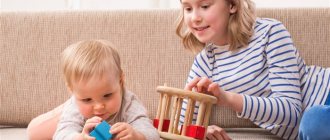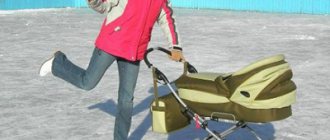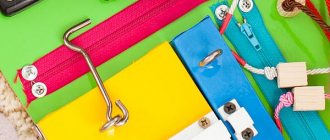After three months of age, the child’s development becomes more and more intensive. Physiological tone disappears, reflexes fade, so now the baby begins to master conscious coordinated movements. His emotions are becoming brighter, he is becoming more and more actively interested in the world around him. How to properly develop a child at 4 months? What activities will help with this?
What should a 4 month old baby be able to do?
Your baby has almost ceased to be bothered by colic and gas, and parents have a short respite before a new serious test - teething. Now you can direct all your efforts to the diversified development of the child, provided that he is healthy and his mental and physical development corresponds to his age. The pediatrician will definitely confirm this, but you can approximately estimate these parameters at home if you are attentive and observant.
Loss of newborn reflexes
Now the child develops acquired skills, and unconditioned reflexes fade away. This indicates that the baby is developing normally. Carry out small tests to determine the extinction of reflexes during the newborn period:
Galant reflex
A newborn bends his back if you run your index finger along the baby’s spine from top to bottom, and to the left and right of the midline of the spine at a distance of up to 1 cm. By the fifth month, this reflex should be absent.
Robinson's grasp reflex
It is replaced by purposeful grasping and holding of objects.
Toe curling reflex
When massaging the feet, the newborn curled his toes inward, but now he should fan them out.
Moro reflex
When the baby is lying on his back, you clap your palms on the surface where the “test” is located to the side at the level of the head. If earlier the baby sharply spread his arms to the sides, and then brought them together as if he was hugging himself, in the fifth month of life this reflex, if not completely extinguished, then noticeably weakened.
Bauer reflex
The Bauer reflex should also fade away: if a newborn baby in a position on his stomach felt support on his heels (an adult’s palm, deliberately pushing), he would try to push off and crawl away. The persistence of this reflex after 5-6 months indicates a pathology in the development of the baby’s central nervous system.
Brief table of skills (physical, emotional, auditory, visual, speech)
What should a four-month-old baby be able to do: a table of average indicators of normal development:
| Skills: | |
| physical |
|
| emotional |
|
| auditory |
|
| visual |
|
| speech |
|
Children who are ahead of their physical development can demonstrate many more skills and abilities - the table shows average values.
Height and weight of a 4 month old child (Russia and WHO)
WHO and domestic pediatrics have somewhat different views on what the normal height and weight of a four-month-old child is. The difference lies in the range of these parameters (WHO has a lower limit and a higher upper limit than Russia).
| Russia | WHO | |||
| Boy | Girl | Boy | Girl | |
| Weight, kg | 5,5-7,6 | 5,4-7,0 | 5,6 – 8,7 | 5,0 – 8,2 |
| Height, cm | 58,7 – 64,5 | 58,4 – 64,0 | 59,7 – 68,0 | 57.8 – 66,4 |
These parameters are average and, first of all, depend on the initial parameters at birth, on the course of pregnancy and the correct course of childbirth, as well as on genetic predisposition.
Anna, mother of five-month-old Darina: “My daughter was born large, 4.2 kilograms! At 4 months I weighed 8.5! The doctor scolded us and reproached us for being obese! But what can you do if everyone in the family is rather big: both me and my husband? Here is the same child! I didn’t give Darinka any complementary foods or supplements, only breast milk, but the weight still exceeds the parameters.”
Hearing Focus
The goal of playing with sound at 4 months is to develop the baby’s ability to recognize sound in space, find its source, develop the ability to recognize the mother’s voice and respond to intonation.
Any objects can be used as a sound source, with the exception of those that produce unpleasant and harsh sounds. Use rattles, children's musical instruments, rustling toys, bells or bells, small hammers, and tumblers to play with your baby so that he listens and finds the object that makes the sound.
Change the location of the sound source and observe the child's reaction. If the baby develops normally, he will definitely turn his head following the sound.
For auditory training, you can use such an interesting attribute as socks with bells. Put on the legs, they will definitely arouse the interest of the baby; he will twitch his legs, trying to find the source of the sounds.
Sounding wind-up toys that sing or “talk” to the baby will become your baby’s favorites.
A 4-month-old child can already take part in the “home orchestra.” Show him how you can make sound from a baby maracas or rattle by shaking it well.
How to help your baby develop fully?
Full development requires a comprehensive approach: a four-month-old baby must develop diversified - both physically and mentally. By introducing an element of play into your daily activities with your baby, you will make development not only successful, but also harmonious.
Educational games and exercises
Educational games for 4-month-old children will be good helpers for proper development. As a rule, there are no special and strictly obligatory games, just as there are no strictly defined times in the daily routine dedicated to games. You can include an element of playing gymnastics, massage, swimming, walking. Even before eating, you can play a little with the baby.
Finger games for 4 month old babies
Tactile sensations directly affect the child’s brain activity.
Finger gymnastics should become the main play tool for parents of a four-month-old child.
What are finger games for 4-month-old children and how to do them?
Very simple. Bending and stroking each of the baby’s fingers, mom or dad say a well-known nursery rhyme about where “little finger” was, with whom he went to the forest, with whom he cooked porridge, with whom he sang songs, etc.
The main part of finger games is accompanied by poetic content. The melody of the verse, intonation, joyful emotions of both the baby and the parent help reinforce finger exercises.
If the baby is stiff and does not open his fingers well , before starting the game, give a relaxing hand massage using exercise therapy techniques:
- Grab your child's wrists and shake them slightly. Then move it to the sides and back, as if a bird is flapping its wings - this exercise will relax the shoulder muscles.
- Grabbing the baby's arms at the elbow joint, shake them - the fingers will relax.
Finger game scenarios
While reading the rhyme, change your tactics: first clench your baby’s fingers into a fist, and then, on the contrary, unclench them.
Our forest house has five floors: On the first there lives a family of hedgehogs, On the second - a family of gray hares, On the third - a family of red squirrels, On the fourth a tit lives with its chicks, On the fifth an owl - a very smart bird. Well, it’s time for us to go back down: On the fifth there is an owl, On the fourth there is a tit, Squirrels on the third, Little hares on the second, On the first hedgehogs, We will come to them later.
Orange
We squeeze the baby’s fingers into a fist and unclench them one at a time:
We shared an orange. There are many of us, but he is alone. This slice is for the hedgehog. This slice is for the swift. This slice is for ducklings. This slice is for kittens. This slice is for the beaver, and for the wolf it is the peel. (we stroke our palm) He’s angry with us - it’s a disaster; Run away - Who goes where! (shaking the pen)
Ladushki
- Okay, okay! Where were you? - At Grandma's. - What did you eat? - Porridge. - What did you drink? - Mash. They ate the porridge, drank the Mash. Whoo-oo... They flew! They sat on their heads, croaked like a cockerel. -re-ku!
Raise your hands up and lower them onto your head
Natalya, mother of 6-month-old Tolik: “Tolik loves classic ladushki. At 4 months he just listened and smiled, and now he also began to raise his hands up and say “oo-oo-oo”.
Physical development (gross motor skills)
At 4 months, the baby should already have fairly developed gross motor skills. This is not only an indicator of the child’s correct development, but also prerequisites for the development of fine motor skills, and, as a result, earlier speech development.
By the fifth month, the child’s tone of the flexors and extensors of the legs and arms is balanced, so movements are necessary to strengthen the muscles of the limbs. This way the baby will be more ready to crawl and walk.
Developmental activities are good to conduct when the baby is full (20-30 minutes after eating) and alert, then they will bring pleasure to both the child and you. While doing the exercises, count out loud: the baby’s auditory analyzer is maturing and his sense of hearing is developing.
This exercise will help strengthen the joints and muscles of the hands. Starting position (IP): on the back. Place your thumbs into the crumbs' palms so that he squeezes them into a fist. Carefully spread the handles to the sides on a count of “one”, and smoothly lift them upward on a count of “two”. On the count of three, pull forward and lower. Repeat 5-7 times.
"Bike"
Add this exercise to your daily gymnastics; it strengthens the leg muscles and develops the hip joints. IP: on the back. Holding the baby by the shins, alternately bend and unbend the legs, making smooth circular movements and making sure that the legs are parallel to each other.
"Airplane"
This exercise helps strengthen the muscles of the neck, back, shoulder girdle and trains the vestibular apparatus. IP: on the stomach. Lift your child under your arms, face forward, and place your heels on your chest. Fly around the room.
Exercises for a 4-month-old baby on a fitball
"Pushers and rockers"
IP: lying on your back. Hold your baby by the shins. On the count of “one”, bend your knees, and on “two”, pull them towards his chest. “Three” - roll the ball back a little so that the legs straighten. Repeat 5-7 times.
"Palms to the floor"
IP: on the stomach. “One” - tilt the fitball, holding the baby by the butt and lower back, so that the outstretched arms touch the floor. On the count of two, return to the starting position. Perform the exercise carefully and only if the baby holds his head and back level well.
Games for speech development
At 4 months, the baby is already humming melodiously, trying to communicate. The task of adults is to maintain a dialogue by responding with the same sounds. At 4 months, it’s time to teach your baby the syllables: “ma”, “da”, “na”.
Read poems to your baby, clearly pronouncing the syllables:
Ma-ma-ma-ma, mommy! Ba-ba-ba-ba, grandma! Doo-doo-doo-doo, pipe! Pa-pa-pa-pa, daddy! Co-co-co-co, kitty!
Sing a song, each time adding new syllables at the end (da-da, na-na, tu-tu):
In the morning I get up, I sing a song, a simple song, this one: La-la-la-la
Development of fine motor skills
To make your child’s fingers dexterous and strong, able to cope with small buttons when it’s time to go to the garden, and to make your child a champion in putting together mosaics, start finger games now.
It has been proven that fine motor skills developed from the cradle make a baby a faster talker!
While charging, work the fingers of each hand in turn. Don’t just rub and massage your fingers, but say simple rhymes at the same time: this will develop the child’s hearing, memory and rhythm.
There lived 5 little children in the mouse house. One loved to eat, another loved to listen to a poem, and the third loved to take a walk, and two little ones loved to sleep.
Place your baby's hand in your palm, back side up, so that the fingers are extended. Grabbing each finger by the tip and holding it with light pressure by the nail and pad, bend it slightly upward, saying:
Guli-guli: One - big, Two - funny, Three - handsome, Four - happy, Fifth - baby, Shoo-shoo-shoo! (make a fist).
Let's go swimming? Don't rush to dive into the bath completely, play! And when the baby begins to sit in the water on his own, combine bathing and finger play.
"Fish-fish"
Supporting the baby under the breast, tilt it so that one palm fits into the water. With your other hand, grab the child’s palm so that you can freely bend and straighten the fingers from the index finger to the little finger at the same time. Sentence:
Little fishes, little fishes, plop-plop with their fins! Squelch-squish with their tails, and swam away into the reeds!
Do your finger exercises carefully! It is difficult for a child to keep them straightened; do not put a lot of effort into straightening your fingers - the joints are very fragile!
Emotional and social development of the child
For a 4 month old baby, communication is a great pleasure. He is not afraid of strangers and listens to voices with interest. The child likes to watch facial expressions. He will be happy to feel your nose and cheeks, stick his fingers in your mouth, and pull your hair. Use this interest for games!
"Ram-ram"
Butt heads with your baby, saying:
Early-early Two rams Met in a meadow. They stood up straight Two rams And not a gu-gu to each other...
On the handles
Teach your child to express his desires not only by shouting. Are you being capricious? Before you take him, stretch out your hands to him, beckon him, forcing him to stretch out his hands to you:
Handles! Come to us! Take the baby quickly!
Etiquette lessons
Etiquette lessons are important now! Teach your baby to say hello and goodbye to people. Every time you accompany your dad to work or your grandmother home, bring the baby to the departing person, performing a certain ritual-game of farewell. For example, pressing your cheek to the cheek of the person leaving, and then waving your hand:
Bye bye! goodbye! Come back more often!
Evgeniy, father of seven-month-old Yegor: “I love it when my son greets me. As soon as I enter the door, Egorka is in his wife’s arms and stretches out her palm to say hello. I’ve greeted him this way since birth, when he probably didn’t yet understand that I was a dad and what this handshake meant.”
Establishing emotional contact
A four-month-old baby begins to be especially wary and wary of strangers. In their presence, he tenses up and may even cry, seeking salvation from his mother, who is now the most important person in the baby’s life. It is with the mother that the little man establishes the closest emotional contact, which is very important for the development of the baby. The child needs to feel his mother nearby every minute.
- Say hello to your baby as soon as he wakes up, smile at him, and do stretches. Be sure to call him by name and say something sweet.
- When putting him to bed, rock your little one in your arms, pat him on the back, and sing a lullaby.
- When bathing your baby, be sure to smile, tell him nursery rhymes, or simply say affectionately: “Who’s going to cuddle up here? It’s Sashenka who will be kup-kup.”
Any situation in a child’s life must be supported by the parents’ emotional attitude towards it. The child must understand that mom and dad can be happy and laugh, or they can be sad and upset.
Vision development
By four months, a child’s vision perceives colors perfectly: natural colors are better, natural ones are yellow, green, red and blue. Pure and bright shades are preferable to halftones and multicolors. Don't go overboard with the variety of toys!
How to train your eyesight while playing?
Take a small bright ball. Place the baby on his tummy, and the ball in the baby's field of vision. Draw the child's attention to the ball, and then roll it from side to side so that the child follows the toy with his eyes. You can say:
Ball-ball, roll, show yourself on each side! Oh, what a beautiful ball! Come on, mom, hide the ball! (You can hide the ball so that the baby notices the absence of the toy).
Concentration of attention
The following trick will help you concentrate your attention and develop your eye muscles. Untie all the pendants from the mobile (hanging bed toy) and replace them with nondescript, plain, one-color ones (you can fill pieces of nylon stocking with padding polyester and tie them like a ball). And tie one bright toy. When the baby watches the mobile, his eyes will be focused only on the bright toy.
Tumbler
Not only vision, but also coordination of movements is developed by mobile toys such as tumblers. Touch the child's hand, rock the tumbler, and until it stops, the baby will not take his eyes off it, rotating his pupils from side to side, which means training the eye muscles.
Attach bright pictures (rags, stickers, even balloons) to the walls in every room where the baby is, and even if the baby can find bright objects on the boring walls in the bathroom or kitchen.
Let's talk a little
As the child’s hearing improves, his speech also develops. In the fourth month of life, the baby begins to pronounce the syllables: “ba”, “ma”, “pa”. Sometimes the baby even bursts out the first “ma-ma” or “pa-pa”, which makes the parents incredibly happy. And soon complex consonants appear - g, k, x, d, v.
Now the baby can convey a feeling of joy and surprise with the help of sounds and intonation. He willingly enters into a “conversation” with his parents and quickly learns new sounds and syllables. Parents should take advantage of this to develop the primary speech skills of a four-month-old child through play.
- “Let’s talk together” - mom starts the conversation with some simple phrase: “Today it’s warm and sunny.” If the baby enters into a conversation, be silent, listen to his “phrase,” nod, and then continue: “Yes, yes, and the birds are singing.”
- “Ba-ba-ba” - put any syllable that the baby uttered to the tune of the song. This greatly amuses the baby and motivates him to repeat the syllables over and over again.
- “Who lives with us?” - hang colorful pictures on the wall. Bring the baby to each of them in turn and say who is drawn. This is a dog, “woof-woof.” Wait a little, giving the child the opportunity to take a good look at the picture and repeat again: “Dog, “woof-woof.” After some time, the baby will try to repeat “woof-woof.”
A conversation with children at this age is simply necessary; it is an invaluable experience for a child. After all, it is at this time that his elementary vocabulary is formed, facial muscles and articulation are developed.
Developing hearing
Always talk to your child!
It doesn’t matter that he doesn’t understand anything about cooking borscht or ironing clothes: comment on your actions! This is the only way the baby’s hearing and speech will develop! It is very useful to rest your baby’s head against your cheek when you speak: he will feel muscle movement and vibration when pronouncing sounds.
No monotony!
Change the intonation and pitch of your voice when speaking, go up to medium volume and go down to a whisper. Be quiet for a few moments to better attract your child's attention.
Listen and repeat!
Let your child speak if he is vocal, and then repeat his “speech.” This will teach the baby to dialogue.
Less “bunnies”, more specifics!
Call your child by name, and not just affectionate words like “sunny, bunny, fish.” This way he will sooner begin to respond to the name and get used to it.
"Ding Ding"
Buy a bell! Shake it to the right side of the baby's head. When the baby turns toward the sound, move it to the left. Ring the bell from different places in the room, forcing your baby to look for the source of the sound.
Turn on the music
Music is needed not only for the development of aesthetic taste and musical ear: it develops children's hearing, has a beneficial effect on emotional development, and develops a sense of rhythm. Turn on the music and sing yourself: all kids like it.
What skills does a baby develop at 4-5 months?
Development of fine motor skills and coordination
By four to five months, babies continue to develop most actively physically. At this age, the first grasping reflexes appear, the child holds his head and even makes his first attempts to sit up. He reaches out to toys, tries them out, getting an idea of the texture and volume of objects.
Development of visual memory and attention
Babies of four to five months already consciously smile when they see mom or dad, babble joyfully and express emotions. The baby can focus his gaze, begins to distinguish between near and distant objects, and finds familiar ones.
Speech development
At the same age, children actively begin to develop auditory perception and speech. The baby turns his head in the direction of the adult’s voice or a sounding toy. Cheerful music can make him excited, while sad music, on the contrary, can make him freeze.
The baby is trying to babble: unlike “cooing,” babbling is a more complex type of speech that prepares your child to pronounce the first conscious sounds and syllables.
Developing speech
As with hearing development, speech development is facilitated by constant communication with the child. Read fairy tales and poems, don’t make excuses that the child won’t understand or remember anyway!
“We often do not suspect that the most ordinary phrases and actions of his mother are imprinted on a child’s brain from birth,” writes the Japanese author of the book “After Three It’s Too Late,” Masaru Ibuka. “So mothers who constantly talk to their children have a strong influence on the development of children’s intelligence.”
“Bah? Or Ma?
You can reinforce the pronunciation of a specific syllable in a child if he hears it often. Try reading a poem using only one syllable, but changing the intonation. In this way, you can help ensure that the baby is the first to fully say the word that you expect from him.
"My voice"
Does your baby gurgle and babble for a long time? Take advantage of the moment, record it on your camera, voice recorder, phone, etc. If necessary, play the recording: the baby’s reaction to his own voice will be vivid!
"Repeat Mom"
We develop a child's speech by actively imitating his babble! After all, if mom speaks like him, then he can do it, like mom!
Cognitive development of a 4 month old baby
By learning about the world around him and himself, the child develops harmoniously.
“A variety of impressions received contribute to children’s cognitive development,” says E.I. Turevskaya. in Developmental Psychology. - Adults surrounding the baby must satisfy this need for impressions and try to ensure that the environment is not monotonous and interesting. The cognitive development of children living in a monotonous environment slows down somewhat.”
The four-month-old baby is interested in his own body. Help him with this!
"Where? Here!"
A game that helps you remember your child's body parts. Ask: “Where are our pens?” (legs, tummy, nose, etc.) And immediately answer: “Here!” (naming a body part)
"Let's fly!"
Body parts can be taught using this game. Take the baby’s hands in yours, wave them, saying:
“Let's fly, fly! They sat on the head (on the tummy, ears, legs, etc.)!” (press your palms to the named part of the body).
“Who is that behind the glass?”
It is useful to play with your baby in front of the mirror. Leave all superstitions aside - educational games with a mirror are educational and exciting. Show the reflection to the child, make a face yourself, kiss the child so that he can see the looking-glass mother kissing the baby: this way the child will be more likely to identify his reflection with himself.
Visual training
The ability to focus your gaze on an object, tracking its trajectory as it moves, the desire to find a toy you like are developmental parameters by which you can assess the level of visual development of a baby.
Hide and seek games
Show the toy to the baby, move it in different directions, hide it behind small and dim sheets of paper, giving the child the opportunity not only to look for the object, but also to mentally follow a certain path of the toy and find it in an unusual place.
Item tracking
Simple trajectories can be replaced with more complex ones over time. Play with your baby in circles, large and small. Place the baby on his back and attract his attention with a bright (possibly with sound) toy, then move it in a circle, gradually increasing the diameter. Take your time, movements should be smooth and measured.
Activities with your baby can be done not only with the help of toys. Leaning over the crib, sing your baby a song or recite a little rhyme, then move to another corner of the crib and again attract his attention.
One mother played with her four-month-old baby using a large teddy bear, hiding behind it and moving the “forest dweller” to different places that the baby could see. The child loved the toy very much, and when he grew up, Mishutka protected him from night terrors. The boy did not part with him until school.
Educational toys
Rattles or maracas
What toys does a 4 month old baby need? First of all, rattles, and the louder they sound, the better. It’s good if among them there are geometric ones (spherical, oval, rectangular - but without sharp corners!), and plot ones (depicting animals, people). A wonderful option is children's maracas. They have a comfortable handle, and they sound very loud. The baby will really enjoy shaking both hands to the beat of the music. The colors of the rattles should be bright and useful for developing vision: green, yellow, blue, orange.
Sensory mats
At 4 months, the child plays and spends a lot of time lying on his tummy, exploring everything that comes to hand. Children's rugs with sewn-on rustling, sound elements and toys made of different fabrics will be useful for the sensory development of the baby.
How to make educational toys yourself?
Educational toys for 4-month-old children can be made independently.
Sensory bags
Sew bags from fabrics of different textures (silk, plush, felt, cotton, etc.), fill with cereals. Such educational toys are useful for the development of a child’s sensory and fine motor skills.
Multi-colored caps
Attach lids from jars and bottles to a sheet of plywood of various sizes and colors. A child will definitely like this educational panel: offer it when the baby is lying on his stomach, he will reach out with his hands to the bright circles. Do not use toxic glue! Fastening with small self-tapping screws will be much more reliable (this will also give strength to the toy).
But before buying educational cartoons, think about it: don’t believe promises to make a child prodigy out of a baby, there will be much more damage to children’s vision!
Sensory games
The baby's sensory sensations can be trained by inviting him to play with small bags prepared in advance. Various fillers (cotton wool, cereal, sand, etc.) are sewn into thick fabric and allowed to be felt by the baby. Tactile new sensations will delight the child and help his development.
When making such attributes, do not forget about the safety of the baby - do not use sharp objects as filler, sew all the parts tightly and use durable material.
If it is not possible to sew such playful didactic materials, then simply use pieces of fabric of different textures - corduroy, raincoat fabric, plush, boucle fabric. You can also use other items made from different materials - plastic, wood, padding polyester, etc.
Olga, mother of 4-month-old Vera: “We bought Veruni several fabric educational toys made of different materials (smooth, rough, rustling), but she quickly got tired of them. High-quality toys are expensive, I didn’t know what to do. Then our grandmother found a way out of their situation: she sewed clothes for her caterpillar from different materials, even knitted one from real wool. I sewed interesting buttons and beads onto them. Every 2 days I changed my “clothes”, and my daughter perceived the toy as new every time!”
Daily routine as an element of development
It is worth accustoming your baby to a routine from birth. Certain hours for sleeping, feeding and playing will bring order to the organization of the day for both the child and the mother.
Walks
By the age of four months, walks become longer, in summer - up to 3 hours, in winter - up to 2. Babies still sleep during the walk, so if the child is not sensitive to the rocking of the stroller and closes his eyes as soon as he is dressed, you can simply put the stroller on the balcony or a veranda, and mom can do housework.
Nutrition
The baby should be fed six times a day; equal periods of time between feedings allow the food to be digested and the stomach to rest.
Massage
It is better to carry out a massage twice a day, at the same time, the child will wait for this procedure, especially if the complex includes not just rubbing and stroking, but games and sentences.
It’s good if going to bed in the evening is a kind of ritual (actions repeated day after day): bathing, a “tenderness session” (stroking and kissing), a lullaby.
Activities for vision development
Already now you can slowly introduce the concepts of the basic properties of an object: size, color, shape - do not overdo it in your efforts - the baby is still too small to master a large amount of information. Children's memory at this age is quite short-term and in order to achieve results, and especially to consolidate them in the child's consciousness, a methodical and leisurely study of the material is necessary. When choosing toys for your child, try to choose those whose colors are not too complex - children at this age prefer solid-colored objects, or painted in a maximum of two or three colors with clear boundaries; a four-month-old baby is not able to perceive variegated colors with complex patterns. The main task of parents is to be patient. Believe me, you will soon be rewarded for your efforts.


